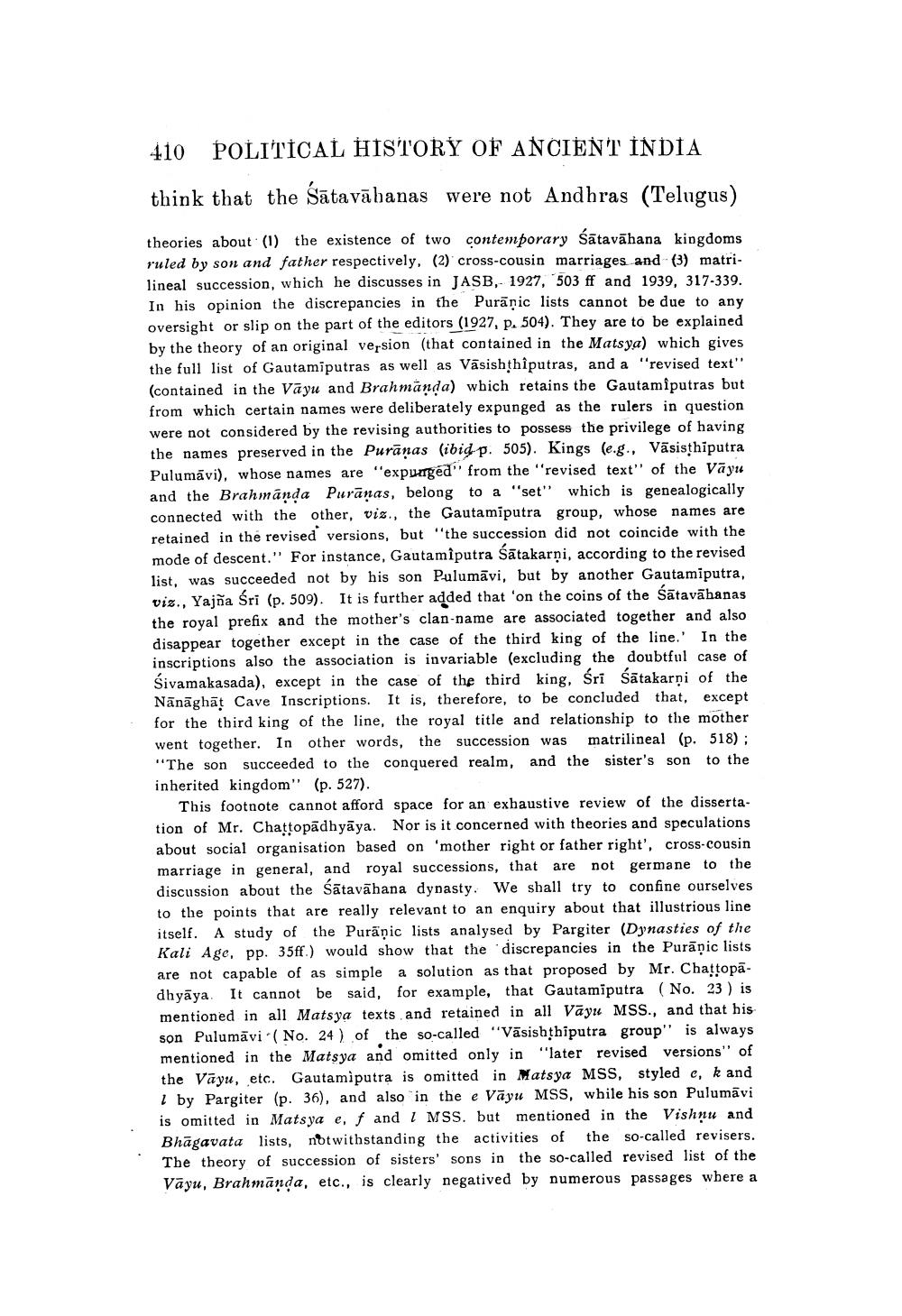________________
410 POLITICAL HISTORY OF ANCIENT INDIA
think that the Sātavābanas were not Andhras (Telugus)
theories about (1) the existence of two contemporary śātavāhana kingdoms ruled by son and father respectively. (2) cross-cousin marriages and (3) matrilineal succession, which he discusses in JASB, 1927, 503 ff and 1939, 317-339. In his opinion the discrepancies in the Purānic lists cannot be due to any oversight or slip on the part of the editors (1927, p. 504). They are to be explained by the theory of an original version (that contained in the Matsya) which gives the full list of Gautamiputras as well as Vāsishthiputras, and a "revised text". (contained in the Vayu and Brahmanda) which retains the Gautamiputras but from which certain names were deliberately expunged as the rulers in question were not considered by the revising authorities to possess the privilege of having the names preserved in the Purānas (ibid. p. 505). Kings (e.g., Vāsisthiputra Pulumāvi), whose names are "expunged" from the "revised text" of the Vayu and the Brahmanda Puranas, belong to a "set" which is genealogically connected with the other, viz., the Gautamiputra group, whose names are retained in the revised versions, but the succession did not coincide with the mode of descent." For instance, Gautamiputra Satakarņi, according to the revised list, was succeeded not by his son Pulumāvi, but by another Gautamiputra, viz., Yajña Śri (p. 509). It is further added that 'on the coins of the śātavāhanas the royal prefix and the mother's clan-name are associated together and also disappear together except in the case of the third king of the line. In the inscriptions also the association is invariable (excluding the doubtful case of Sivamakasada), except in the case of the third king, Sri Satakarpi of the Nānāghāt Cave Inscriptions. It is, therefore, to be concluded that, except for the third king of the line, the royal title and relationship to the mother went together. In other words, the succession was matrilineal (p. 518) ; "The son succeeded to the conquered realm, and the sister's son to the inherited kingdom" (p. 527).
This footnote cannot afford space for an exhaustive review of the dissertation of Mr. Chattopadhyāya. Nor is it concerned with theories and speculations about social organisation based on 'mother right or father right', cross-cousin marriage in general, and royal successions, that are not germane to the discussion about the sātavāhana dynasty. We shall try to confine ourselves to the points that are really relevant to an enquiry about that illustrious line itself. A study of the Puranic lists analysed by Pargiter (Dynasties of the Kali Age, pp. 35ff.) would show that the discrepancies in the Purāņic lists are not capable of as simple a solution as that proposed by Mr. Chattopadhyāya It cannot be said, for example, that Gautamiputra (No. 23 ) is mentioned in all Matsya texts and retained in all Vāyu MSS., and that his son Pulumāvi (No. 24 ) of the so-called "Vāsishthiputra group" is always mentioned in the Matsya and omitted only in "later revised versions of the Vayu, etc. Gautamiputra is omitted in Matsya MSS, styled e, k and I by Pargiter (p. 36), and also in the e Vāyu MSS, while his son Pulumāvi is omitted in Matsya e, f and I MSS. but mentioned in the Vishnu and Bhāgavata lists, notwithstanding the activities of the so-called revisers. The theory of succession of sisters' sons in the so-called revised list of the Vayu, Brahmānda, etc., is clearly negatived by numerous passages where a




